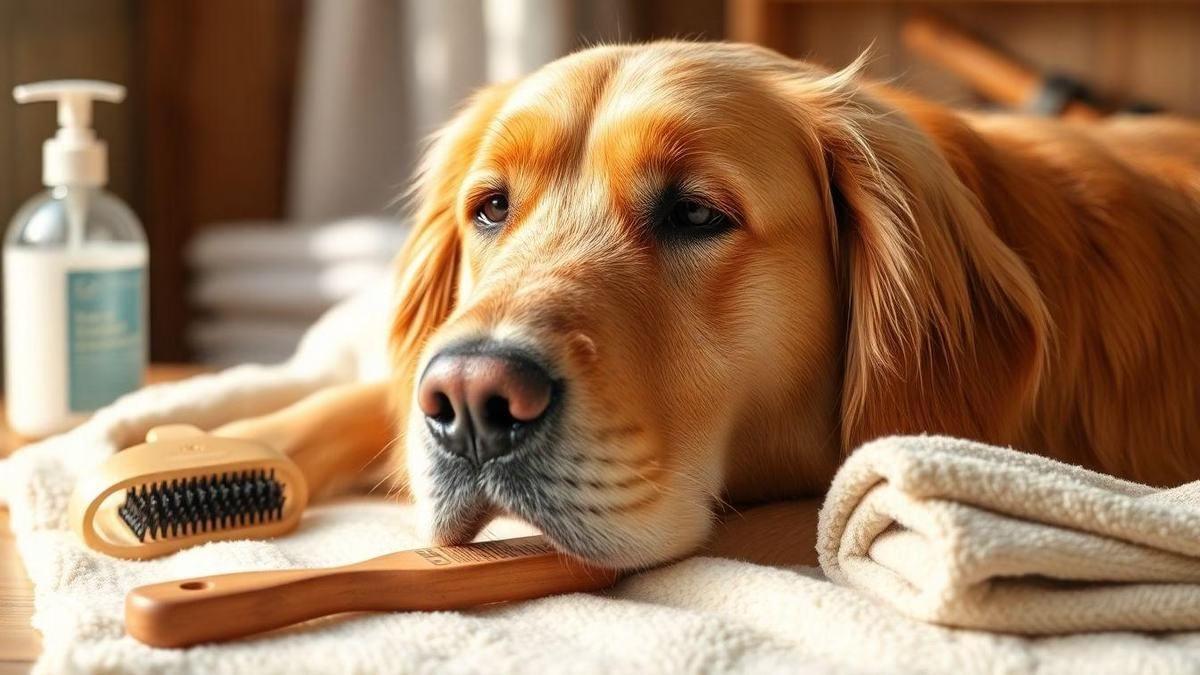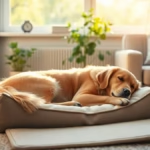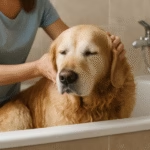Gentle Grooming Tips for Senior Golden Retrievers is my friendly little roadmap for calm brushing, easy baths, safe nail trims, gentle ear care, and picking the right products for an aging coat. I keep sessions short and silly. I use slow, calm touch and lots of treats and praise. I watch for stress signs and stop when my golden gives me the look that says no more. I favor soft brushes and gentle shampoos for sensitive skin. I trim nails carefully and find the quick without pain. I clean ears gently and call the vet if I see trouble. I’ll share simple steps, smart tools, and how I track changes with a photo log and short notes that tie into my daily comfort routines for senior Goldens so grooming stays gentle — and even a little fun for both of us.
Key Takeaway
- Brush gently to avoid sore spots.
- Give quick warm baths with gentle shampoo.
- Check ears, teeth, and skin often for problems.
- Trim nails slowly on a soft, non‑slip mat.
- Use praise and treats so grooming feels positive.
How I use Gentle Grooming Tips for Senior Golden Retrievers with low-stress methods
I started using Gentle Grooming Tips for Senior Golden Retrievers after my old buddy, Rufus, began favoring naps over bath time. At first I treated grooming like a chore—big towel, loud dryer, full production. It failed. Now I do small, friendly rituals that respect his slower pace. I talk to him the whole time, like I’m narrating a nature show nobody asked for but he clearly enjoys. Creating calm surroundings and predictable routines makes a huge difference; I borrow ideas from guides on creating calm and peaceful environments for senior Goldens when I set up the space.
My routine is simple and predictable: tiny chunks—one minute of brushing, a quick ear check, a sniff break. Consistency matters more than fancy gadgets. Over time Rufus stopped tensing and started wagging before I even got the brush out. Grooming became our quiet ritual: comfort and connection, not speed. I watch his body, adapt the pace, and celebrate tiny wins.
Short sessions, calm touch, and slow desensitization
Short sessions are my golden rule—pun intended. I keep each session under five minutes at first so grooming feels like a snack, not a marathon. Calm, steady hands and slow movements are key. I introduce tools slowly—near the nose, then one slow stroke—repeating over days to desensitize without stress. These moments work well when paired with gentle training methods for senior Goldens that emphasize patience and progressive exposure.
- Start with 1–2 minutes of light petting.
- Introduce the tool, let him sniff.
- One slow stroke, then praise.
- End with a treat and quiet praise.
Using treats and praise to make grooming a good time
Treats are the magic glue. I use soft treats that dissolve, vary rewards (cheese, a small biscuit), and pair them with warm words. The tone matters more than the words—good boy, easy, and the occasional, Look at you, a handsome senior! Mixing treats, praise, and a favorite blanket makes grooming feel like a mini spa day. Positive approaches work best; I follow the ideas behind positive reinforcement for senior Goldens to keep the experience uplifting.
Recognizing stress signs early and pausing to help
I watch for lip licking, yawning, turning the head, a tucked tail, or freezing. When Rufus shows any, I stop and calm him. Sometimes a five-second pat resets him; other times we call it quits and try later. Pausing prevents fear from growing.
| Stress sign | What I do next |
|---|---|
| Lip licking / yawning | Pause, give a treat, speak softly |
| Turning head / backing away | Stop, remove the tool, pet gently |
| Tense body / tucked tail | End session, short walk, try later |
Brushing tips I follow for my older Golden Retriever coat care
I call my approach “Gentle Grooming Tips for Senior Golden Retrievers” because my old guy prefers a spa day that resembles a slow waltz, not a wrestling match. His coat thinned and his skin got thinner, so I trade speed for patience. Short, calm sessions keep him happy and prevent tugging on fragile fur.
I brush while he naps on his favorite blanket, talk to him soothingly, and give treats between strokes. That small ceremony keeps mats from forming and makes brushing a treat, not a chore. I rotate three tools gently: a soft bristle or rubber brush for fine areas, a pin brush for guard hairs, and a gentle rake for loose undercoat when he’s not sore. I sometimes combine light grooming with a short therapeutic massage routine to ease aches and encourage circulation.
Best brush types for senior golden retriever coat care
For older Goldens I favor soft tools. A rubber curry or soft-bristle brush is great for daily strokes and massaging the skin without pain. A pin brush with rounded tips works for the outer coat—used lightly so I don’t pull. Avoid stiff metal slickers on sensitive spots.
When undercoat builds up, a fine-toothed rake used briefly helps without digging. Always check tools for rust or sharp edges. If he has hot spots, skip brushing and use fingers to loosen tangles. For more on protecting aging skin and coat I follow principles from the coat and skin care for senior Golden Retrievers guide.
| Brush type | Best for | When I use it |
|---|---|---|
| Soft rubber curry | Daily loose hair, massage | Quick daily rubs while he relaxes |
| Soft-bristle brush | Fine topcoat, shine | Gentle runs after dinner naps |
| Pin brush (rounded tips) | Guard hairs, smoothing | Light sessions 2–3 times/week |
| Undercoat rake (fine teeth) | Removing loose undercoat | During shedding season, short bursts |
How often I brush to prevent mats and reduce shedding
I brush a bit every day and do deeper sessions two to three times a week. Daily short strokes cut down loose hair and stop small tangles from turning into mats. During heavy shed (spring and fall) I increase sessions and use the rake carefully. Short, consistent brushing beats long, infrequent scrubs every time.
Gentle brushing strokes and safe handling techniques
I use slow, short strokes and keep the skin taut with one hand while brushing with the other to avoid pinches. I support joints when reaching hips or shoulders, stop if he flinches, and use treats and breaks.
Step-by-step:
- Calm him with a soft voice and a pet.
- Check skin for bumps, sores, or heat.
- Start with a rubber or soft brush in long, gentle strokes.
- Work in small sections, moving with hair growth.
- Use the pin brush lightly for outer coat and the rake briefly if needed.
- End with praise, a treat, and a cuddle.
How I bathe my senior Golden safely to protect skin and coat
I treat bath time like a spa day with slightly fewer cucumber slices. Before water, I brush to remove loose hair and tangles—this cuts down matting and keeps shampoo from getting trapped. I keep towels, a non-slip mat, treats, and a small cup or handheld sprayer close. I avoid pouring water on his face and ears and use slow, steady motions.
Rinse thoroughly until water runs clear—leftover soap dries the skin. Pat dry, press rather than rub, and follow with a short brushing session once mostly dry.
Choosing shampoos for skin and coat issues in aging golden retrievers
Not all shampoos are equal. I pick formulas labeled for sensitive or aging skin, with moisturizing ingredients like oatmeal or glycerin. If there’s a rash, red patches, or a yeasty smell, I call the vet before using medicated shampoo. For simple dryness, a mild, pH-balanced shampoo works well. I skip heavy perfumes. For a longer hygiene checklist I often consult a hygiene care for senior Goldens reference.
| Shampoo Type | Use When | Key Benefit | My Note |
|---|---|---|---|
| Oatmeal / Sensitive | Dry, itchy skin | Soothes and adds moisture | Great for weekly baths |
| Hypoallergenic | Allergies, irritation | Low irritants and fragrances | Gentle on thin, old skin |
| Medicated (vet) | Infections, severe yeast | Targets fungus / bacteria | Use only with vet guidance |
| Moisturizing | Dull coat, winter dryness | Restores oils and shine | Good for older coats, sparingly |
Water temperature, gentle rinse, and careful drying
Keep water warm, not hot—think warm tea. Test with your elbow; if he shivers, it’s wrong. Rinse carefully with handheld sprayer or cup, avoiding ears and eyes. After rinsing, blot with towels and, if tolerated, use a low-heat or cool blower at a distance to prevent matting. Using a non-slip mat and setting up grooming in an accessible spot follows tips from guides on adapting your home for a senior Golden.
Bath frequency guidelines and post-bath checks
Most senior Goldens do best with baths every 4–8 weeks, adjusted for weather and activity. After a bath check ears, paw pads, skin folds, and nails while he’s calm.
- Dry ears gently and check for redness or smell
- Brush coat and check for new lumps or hot spots
- Inspect paw pads for cracks or debris
- Reward him so baths end well
Nail trimming tips I trust for my aging Golden Retriever
Benny taught me nail care is part science and part gentle bribery. I sit on the floor, Benny in my lap or paw on my knee. Short sessions—two minutes—are better than an afternoon of wrestling. I trim a little at a time and stop if he twitches. Regular short trims keep the quick from creeping out and make walks easier on sore joints.
Tools and step-by-step technique for nail trimming tips for senior golden retrievers
My kit: grinder, guillotine clippers, styptic powder, soft treats, flashlight for dark nails, towel to steady a paw. The grinder is my go-to for thick nails; it’s kinder and lets me shape slowly. For a fuller routine on paw and pad care I reference a guide to nail and paw pad care for senior Goldens.
Routine:
- Let him sniff the tools while I praise him.
- Start with a short grinder session, rounding the tip.
- Clip tiny bits if needed—never more than a millimeter at once.
- Use the flashlight to check the quick on dark nails.
- If bleeding, press styptic powder and a clean cloth.
- Reward immediately.
How I find the quick and trim without pain
Light nails show the pink quick. For dark nails, shine a flashlight from below—the quick looks like a darker oval. If I can’t see it, I trim tiny bits and watch the cut surface; when the color shifts, I stop. Grinders heat slightly, so I move slowly and cool the nail with my breath if needed. If he flinches, I pause and try later. When in doubt, leave more nail and trim again in a few days.
When I call a groomer or vet for safe nail care
I call a pro when nails are too thick, the quick is long, nails bleed and won’t stop, or the dog limps after a trim. For anxious seniors or those with health issues, a groomer or vet can sedate safely and do a calm, full trim.
Ear care routines I use to keep my senior Golden comfortable
I check ears often. Gentle Grooming Tips for Senior Golden Retrievers taught me to treat ears as sensitive real estate. I inspect for smell, dampness, and stray hairs. My routine is short—three to five minutes—and ends with a treat so he thinks I’m a magician, not a nurse.
I clean twice a week unless I spot trouble. I use a soft cloth or cotton ball moistened with a vet-approved ear cleaner. I never poke deep or use cotton swabs. After cleaning, I blot the outer ear and let it air for a minute.
Safe cleaning steps for ear care for senior golden retrievers
I warm the cleaner in my hands, cup the ear flap, squirt a little at the entrance—not deep—massage the base for about 20 seconds, let him shake once, then mop the outer area.
- Gather supplies: cleaner, cotton balls, towel, treats.
- Warm cleaner in hand.
- Apply a small amount at the ear entrance.
- Massage the base for 15–20 seconds.
- Wipe outer area clean and reward.
If he flinches sharply, stop and comfort him. Never use alcohol, hydrogen peroxide, or anything that stings. If cleaning increases redness or swelling, call the vet. For a broader hygiene checklist, see the hygiene care for senior Goldens resource.
Signs of infection or wax buildup I watch for closely
Look (and sniff) for bad odor, dark or green discharge, redness, thick brown wax, excessive head shaking, or pawing. Balance problems or sudden hearing shifts are red flags—call the vet.
| Sign I see | What I do |
|---|---|
| Strong odor or colored discharge | Call vet; avoid home chemicals |
| Excessive head shaking or pawing | Inspect gently; vet if persistent |
| Redness, swelling, or heat | Stop cleaning; seek veterinary exam |
| Sudden hearing or balance issues | Emergency vet contact |
I log chronic issues with dates and notes. That timeline helped the vet change meds once and stopped the head-shaking habit.
Choosing ear-safe products and when to stop
Pick alcohol-free, pH-balanced cleaners recommended by your vet. If a cleaner makes him wince or cleaning worsens redness or discharge, stop immediately and call the vet. Gentle and short beats aggressive and ineffective.
Picking grooming products and managing skin and coat issues in my senior Golden
Senior Goldens are like divas with better manners: fur thins, skin dries, and they sulk if a brush is too rough. Gentle Grooming Tips for Senior Golden Retrievers means choosing mild ingredients, short ingredient lists, and clear directions. If a shampoo reads like a chemistry exam, I put it back.
My routine: hypoallergenic shampoo every 2–4 weeks, a leave-in conditioner on rough spots, and a soft-bristle brush for daily light strokes. Baths are about comfort now. I monitor smell, color, and texture. Patchy coat, funky smell, or inflamed skin means I stop, tweak products, or call the vet. Small changes—omega-3s in food, switching shampoo, gentler brushes—can make big differences. I build these product choices into a predictable plan inspired by advice on creating a healthy routine for senior Goldens.
Selected grooming products for senior golden retrievers and why I use them
I prefer coconut-derived cleansers, oatmeal, and aloe. For conditioner, a light pH-balanced formula. Tools: soft-bristle brush for daily comfort, a slicker for gentle detangling once a week, and a rubber curry brush to lift dead hair without pulling. Nail trimmers with a safety guard and a soft ear-cleaning solution round out the kit. I avoid heavy deodorizers.
| Product | Why I use it | Frequency |
|---|---|---|
| Hypoallergenic oatmeal shampoo | Cleans without drying; soothes itching | Every 2–4 weeks |
| Leave-in conditioner spray | Softens dry patches; detangles gently | As needed |
| Soft-bristle brush | Daily comfort strokes; reduces shedding | Daily |
| Rubber curry brush | Removes loose hair without pulling | 1–2 times weekly |
| Ear cleaner (gentle) | Prevents infections; keeps ears dry | Weekly or per vet advice |
Managing common skin and coat issues in aging golden retrievers with simple steps
Aging goldens often get drier skin, hotspots, and more shedding. For dryness try fatty acid supplements and a moisturizing shampoo. For hotspots, keep the area clean, clip hair around it carefully, and use vet-recommended topical treatments. If shedding spikes, check diet, allergies, and thyroid signs. When in doubt, call the vet. For additional product and care ideas see the coat and skin care recommendations.
- Inspect coat weekly for redness, bald spots, sores, or bumps.
- Switch to gentle, moisturizing products and add omega-3s if flaky.
- Keep baths infrequent but soothing and grooming sessions short.
- Photograph suspicious spots and monitor for changes over two weeks.
- Contact the vet for infections, persistent hotspots, or sudden hair loss.
Tracking changes over time and consulting my vet
I keep a photo log with dates and notes—after baths, after walks, and close-ups of odd spots. That log has saved us from panic and unnecessary visits. When I do go to the vet, clear notes and photos speed diagnosis and reduce pokes and prods. My approach draws on lessons from lessons learned caring for senior Goldens.
Quick checklist: Gentle Grooming Tips for Senior Golden Retrievers
- Keep sessions short (1–5 minutes) and consistent.
- Use soft brushes and gentle, pH-balanced shampoos.
- Introduce tools slowly and let sniffing happen.
- Reward with soft treats and lots of praise.
- Rinse thoroughly and dry carefully to prevent irritation.
- Trim nails in tiny bits or use a grinder; have styptic powder ready.
- Clean ears gently with a vet-recommended solution; never poke deep.
- Log changes with photos and call the vet for infections or sudden issues.
Conclusion
I’ve learned grooming a senior Golden is less about speed and more about comfort, consistency, and a little theatrical praise. I keep sessions short, use a calm touch, and reward with treats so grooming feels like a spa day, not a wrestling match. I watch for stress signs and stop the moment I see the no more look. I favor soft brushes, sensitive shampoos, careful nail trims, and gentle ear care. When in doubt, I call the vet. I track changes with quick photos and notes — that timeline has saved us more than once. Small, regular rituals beat epic scrubs every time.
In short: be patient, be gentle, and keep it predictable. My Golden gets the dignity; I get fewer tumbleweeds on the couch. Want more tips and goofy anecdotes? Explore more everyday joys with my senior Golden and real stories of Goldens who thrived in their senior years.

Rafael Souza is a digital marketing strategist and lifelong dog enthusiast. Passionate about Golden Retrievers, he shares practical, research-based tips to help owners provide healthier and happier lives for their furry companions.





